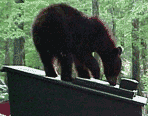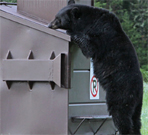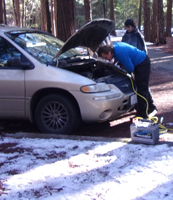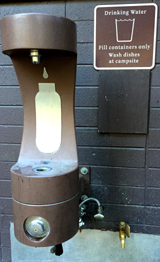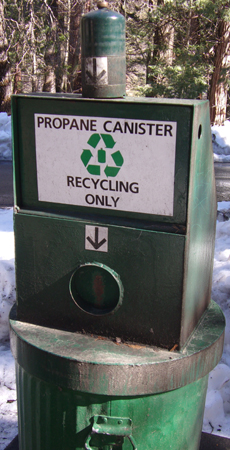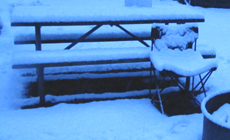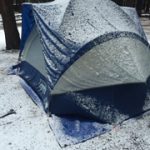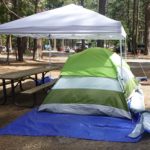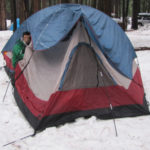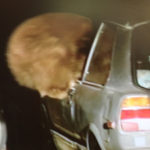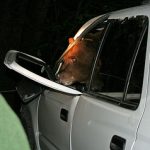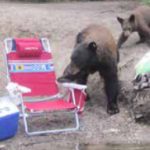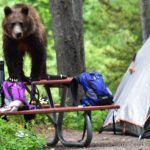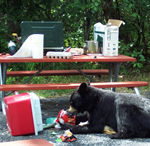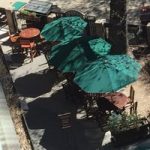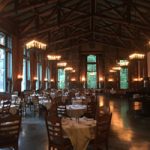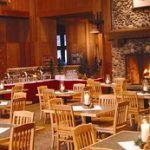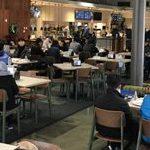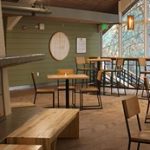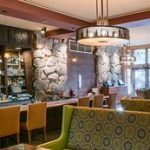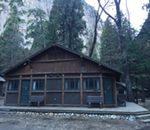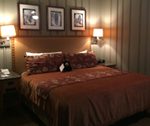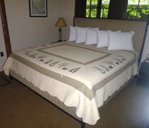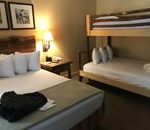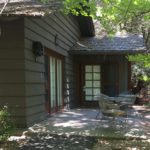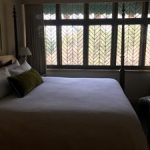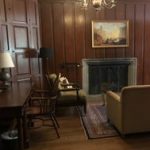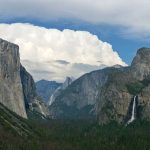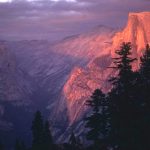These are instructions for first-time campers
(or people who camped (especially in the winter) before and did not enjoy it)
for the De Anza College Outdoor Club trips.
Experienced people will probably pick up a few useful ideas.
This also applies to people staying in Yosemite hotels, tent cabins or cabins in the winter.
For a list of required equipment (and another list of the things you will really wish you had) as well as menu advice, and a discussion of what to look for in long-johns, fabrics and rain gear, go to:
Snow or rain camp must-haves We put info about lots of potential gear rentals and budget minded clothes ideas there.
Snow Camp is the main trip page.
The park service said: “Cell phone coverage in Yosemite is spotty . . . Cell service is often impacted during daily peak visitation by the large number of people trying to access limited service; if you have four bars of service, but you can’t get a signal, this is why . . . cell coverage depends on your phone, the cloud cover and other seemingly mysterious factors and is not always reliable. ”
Many winters a few Yosemite valley bears never go into their winter dens,
but stay active and looking for food all winter.
Yosemite announced, shortly before our 2023 trip:
From the Yosemite Daily Report
January 25, 2023
“Winter Bear Activity
We have had a great winter full of storms and snow. Generally people assume once it snows the bears are hibernating, but they aren’t all hibernating this winter! Bears won’t always hibernate if they have enough food to make it through the winter. This year was a big acorn year for certain species of oak trees, so bears are still eating enough to sustain them. There are still at least three active bears in Yosemite Valley and one in El Portal. . . ”
We can expect the same bear activity every winter in Yosemite, either because some bears do not go into hibernation, or they do, but wake up mid-winter.
On one trip, after a February snow fall, we found bear paw prints in which you could clearly see claw indentations:
Bears in Yosemite break into vehicles, tents and tent cabins that have food or toiletries in them.
The bear below bent the door open to get in the car.
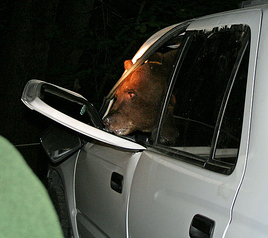
This photo is from a Yosemite visitor center video. It shows a man trying to fold his car door back into place after a bear pulled it open, climbed in and trashed everything in his car (you can see Curry Village tent cabins in the background):
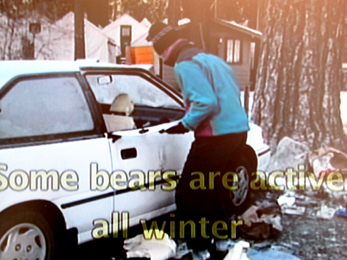
The Park service put bear-proof metal food storage lockers in all the campsites, next to Curry Village (briefly named Half Dome Village) tent cabins and at picnic areas and some trailhead parking lots.
(But they are bear-proof only if used properly.)

Using a campsite or tent cabin food storage locker has this advice and more: Bears break into vehicles (including car trunks), tent-trailers or tents to get at food or even containers shaped like food seen through the windows, so campers need to put all food, ice chests, toiletries, stoves with spilled food, water bottles that had are now empty but had lemonade mixed in them, trash that didn’t quite get to the bear-proof dumpster, pans and dishes in the bear box.
You can’t trust your own nose; look around the car, including under the seats, and in the glove compartment, thoroughly.
Hey, no scented air fresheners hanging from the rear-view mirror!
Puuuuuulease get rid of the dashboard hula girl that emits the pina colada scent,
(only $2.99 at the Frys one day Flash Sale and you couldn’t resist)
and everything else scented from your vehicle so the bears won’t be tempted to break in.
Stop stuffing the ashtray with gum wrappers. Dig the old french fries out from under the seats.
No water bottle, bottle of brake fluid or spray can of deicer showing, the bears don’t know it’s not food and will break into your car because they see an item the shape of a food container.
A daypack/backpack is also a food container to a bear, so you should not leave even an empty pack visible in the car.
The best policy is to leave your car cleaned out of gear visible through the windows.
Air out your vehicle if you eat burgers/pizza on the way to the park.
Bears can get into locked rooftop car storage pods.
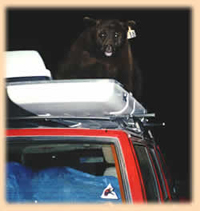
Setting your car alarm will not keep bears from getting into your car, but it can wake up everyone in the vicinity, so it is not allowed on our trips.
Just because people are in the campsite or there is a big campfire burning does not mean that food not locked in a bear box is safe from animals. If you leave a box of groceries sitting while making trips back and forth from the car they’ll get into it, even though there may be people nearby. Raccoons may climb in through an open car door or into a truck bed and drag off a whole loaf of bread while you are unpacking.
- be certain someone stays in the back of the truck to guard gear from raccoons until it is all unloaded and dealt with
- make sure the car doors are shut as each item is unloaded so raccoons don’t get in.
Footprints on dirty window from a raccoon who inspected a car:
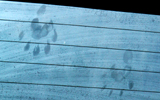
In the morning deer may wander through the campground. You’ll grab your camera to get a picture, forget about the sweet rolls on the picnic table, and before you know it, the deer are eating your breakfast.
Likewise while on a hike, leave your snacks in a daypack pocket, and leave the daypack on the ground, and ground squirrels can chew into the pack in seconds.
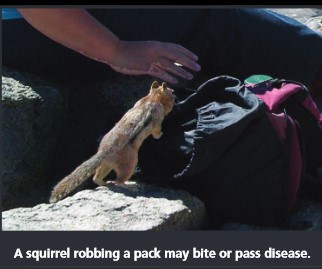
When camping with a large group of people we have found that some complain there is not enough room in their shared bear box for all their gear. (For many years the Rangers let us use bearboxes in closed campsites in the rest of the campground, but in 2004 a Ranger said we would need to buy more campsites instead and that has been the policy ever since.)
There won’t be room for everyone’s gear if we don’t plan ahead. Each person on the trip who shares a campsite with a total of six people must agree to use only the space in one sixth of a bearbox. (Or if you share a tent cabin with 2 or 3 other people, use only one half to 1/3rd of the space). A paper bag used to hold food in the bearbox will disintegrate from melted snow or rain. More on the logistics of using bearboxes is at Using a campsite or tent cabin food storage locker .
NO, you can’t keep a bear out of your campsite, but you can keep them put of your food. More details are at BEARS.
Please use the clip on the trash bin to lock it. If a bear gets into a dumpster on a hot day it can be a death trap.

If you notice one is un-clipped, please clip it.
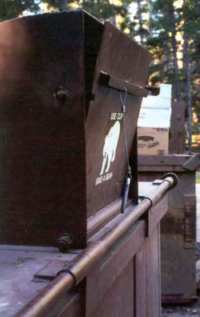
Immediately report it to a hotel front desk, ranger or campground host if the clip is missing from the dumpster.
In the photo above, the note on it says:
“Dumpster Full
This dumpster is full and has been wired shut to prevent black bears from accessing the overflow trash. Please do your part in protecting Yosemite wildlife by finding another dumpster to dispose of your trash. Thank you.”
PLEASE, when a dumpster is full don’t just leave your trash sitting next to it, or try to stuff it in,
find another dumpster.
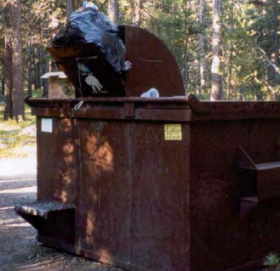
Why do campground dumpsters need to have signs that say: Do Not Play on or Around?
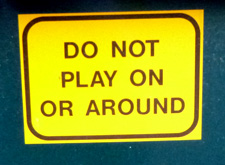
__________YOUR VEHICLE____________
Watch out where you park when you are near buildings:
From a newspaper report: “ a woman called and reported that her car had been broken into during the night while it was parked at her hotel. The woman said her back windshield had been broken, and her car had been “trashed.” Police arrived and determined nothing was taken from the vehicle. Due to the presence of snow and ice inside the vehicle, officers determined the damage was caused by an icicle that fell on the vehicle, smashing her back windshield.”
Wise winter travelers lift the wiper blades off their windshield as soon as they park, or at least before the snow starts, so the blades won’t be frozen on the windshield in the morning:
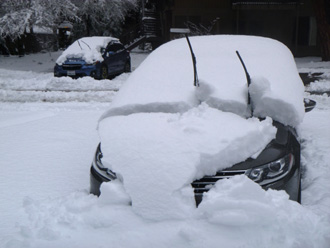
If you didn’t pack enough proper gear to stay warm overnight on our snow camp trip, and you decide to try sitting in the car to warm up, with the engine running in the middle of the night, not only will you risk waking up everyone else, you could make it difficult or nearly impossible to start the car later when you want to go home. Prepare for winter driving has the reason why, a link to bad weather driving tips, tips for using tire chains, tricks for dealing with frozen car locks, how to prepare your vehicle for winter driving, a winter survival kit for your car, what to do if you get stranded, how to keep windows from fogging up and tips for driving in snow and ice.
! ! ! ! Tent walls are thin. You can wake up everybody in the vicinity ! ! ! ! when you want to get into your car and you use the keyless (remote) door opener and the car makes the usual loud beep. People don’t think to just use the key to open the door or don’t know that if you look in the owner’s manual you can find a way to disable the beep. On De Anza Outdoor Club trips you are required to either disable the beep or not use the remote (remove it from your key chain during the trip) or park at the very back of the day use parking lot instead of at the campground.
Some vehicles have a beep activated whenever you open the trunk, that can’t be easily disabled. Every time the trunk is opened it beeps and it will wake up people on our trip and in neighboring campsites. If your vehicle has this function, either look in the owner’s manual for info on how to disable the beep or take it to the dealer and get it done, or do not park it at the campground.
If you rent a vehicle you should learn how to turn off car alarms/disable beeps at the rental business, BEFORE you leave for the trip and be sure the rental company will let you use chains. (A rental company explained chains policies this way “Most rental car companies discourage or forbid the use of snow chains on their vehicles. The reason is chains can cause damage to the vehicle’s wheel wells, tires, or to the road if not installed properly. Many rental contracts explicitly prohibit installing tire chains or cables. If you were to ignore that and damage the car, you’d likely be liable for the repairs, not to mention voiding insurance coverage.”)
The last morning it could be wise to try to start your car before you even start packing up, and warm it up for at least 5 minutes. Then if it won’t start you have more time to deal with it, instead of being all packed up and then finding out your car won’t start.
Do you need a car with a better battery ? (In cold weather, batteries are 50 per cent less efficient) If the owner of the Buick below had cleaned the battery terminals before the trip the half hour spent trying to get his car to start on the 2016 trip could have been spent on something more fun. Read Prepare for winter driving and Road trip vehicle prep and recommended service.
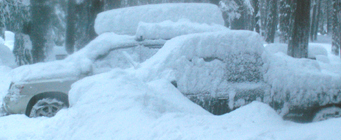 Clean the snow off the whole hood or it will slide and blow up on the windshield as soon as you drive off.
Clean the snow off the whole hood or it will slide and blow up on the windshield as soon as you drive off.
Clean any snow out of the windshield air intake on the hood.
Spray a little deicer on the windshield washer nozzles.
Snow left on the roof will slide down on to the rear window, blocking visibility and the use of any rear wiper, or slide on the windshield the first time you hit the brakes.
Clean any snow away from the exhaust pipe.
Clean off all the lights.
If you want to bring some snow home for a snowball fight with your roommates, fill a now empty ice chest. (This advice is from: Prepare for winter driving which even passengers should read in advance of the trip.)
The roads in campgrounds are not plowed as often as the main roadways, but if one of us with four wheel drive goes around the campground loop a couple of times we can make it easier for others to get out at the end of the trip:
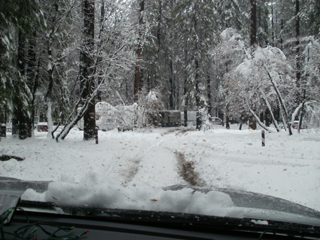
People staying in hotels, cabins and tent cabins are not allowed to cook in their rooms and will need to find a picnic area to cook out, or hope they can share a campsite someone has for cooking.
Do dishes the easy way. Many campgrounds will have signs up giving some specific directions. Most don’t want you to do dishes in restroom sinks as the little bits of food clog the sink and the smell of food lures animals, (yes, even bears), into the restroom.
Some directions say to fill a wash basin you brought with you with water, do the dishes at your campsite and then dump the dish water into the toilet OR into a specific utility sink for waste water, often located in the restroom building, but separate from the restrooms. Don’t pour waste water on the ground.
In the pictures below, the Yosemite restroom building has men’s and women’s restrooms on either end and a center room, ( with an outside door different than the restrooms doors) that has a basin for waste water disposal.


The easiest way is to do messy cleanup cooking as much as possible at home in advance, like grease-producing bacon, and then just reheat the food in camp. When it’s time to clean up, start by wiping off the dishes and pans with paper towels. Then you can use just a little soapy water to wash with and will have less waste water to carry and dump.
OR plan meals that won’t require a lot of cooking or cleanup-

OR (for a short weekend trip) – wipe off the dirty dishes and put them in the ice chest and bring them home to clean them.
Your water bottle will probably not fit under the sink faucet, but most Yosemite restrooms, and many other locations, have water bottle filling stations on the outside wall (and notice the faucet just below the water-bottle filler for fast filling of gallon containers, such as the ones you brought to be able to put out your campfire).
——-Campground quiet hours are from 10 pm to 6 am.——
https://www.nps.gov/yose/planyourvisit/campregs.htm
A large group in multiple campsites is bound to be noisy at times, but noise is the first thing other campers complain about to the Rangers. When a friend who is enjoying herself immensely starts singing loudly at midnight, please remind her that people are trying to sleep.
If you want to talk to someone in another campsite, go there and talk, don’t yell.
Turn off the car stereo before you enter the campground, and don’t use your car stereo to broadcast music to the campsite. The best music solution really is to bring headphone cassette players so you can play whatever music you want as loud as you want. We promise not to snicker too much at your air guitar but we might place bets on which song you’re listening to. Or skip the music and listen to Mom Nature’s avalanches, and if we’re lucky, coyotes singing.
The club encourages acoustic guitars if everyone nearby wants to hear them, but does not allow drums, tubas, …
This advice on how to use a tent and how to use a sleeping bag applies to all year, not just winter.
It could turn out to be wise to bring a tarp to cover an older tent, even if it looks good.
But we must be sure we only have tents pitched for a maximum of six people per site, (Yosemite park rules) and not disturb the ground “digging, trenching and leveling of the ground is prohibited,”
Where you pitch your tent within a site is important..
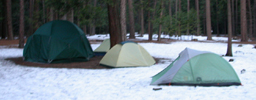 When we arrive and set up camp, there might not be any snow on the ground in some parts of our campsites, or very little.
When we arrive and set up camp, there might not be any snow on the ground in some parts of our campsites, or very little.
If you pitch your tent in an area with trees, and it snows, the trees will catch some of the snow as it falls, putting less weight of snow on your tent. But when the clouds clear, and the sun warms the snow on the branches, it will melt and come down off the branches, sometimes right down the back of your neck if you are unlucky in where you happen to be standing. In most campsites this will be your only choice, but some have space clear of trees where you’ll have less snow falling off tree branches, but more weight of snow on your tent itself.
Pitch the tent with the front door facing towards sunrise to have sun flooding in the entrance in the morning. Or pitch it with the entrance towards the best view, so you can unzip the door in the morning and enjoy the view while still snug in your sleeping bag.
The easiest way to pitch a free-standing two- or four-person tent during precipitation is to pitch a dining canopy first, pitch the tent under the dining canopy and then move the tent to where you will sleep.
Late arrivals can usually find earlier arrivals (if they are still awake) to help them pitch their tent:
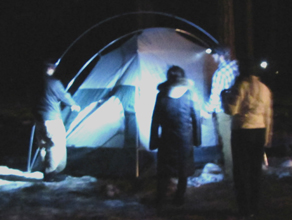
Pitch your tent by yourself when you arrive after dark and in the morning you might discover you put the rain fly on upside down:
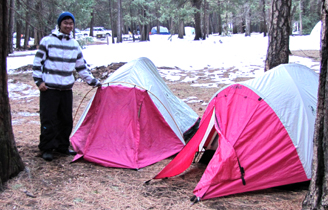
It seemed like a good idea Friday afternoon when moving into the campground to anchor tent guylines to branches buried in the snow until two mornings later after steady rain Friday night and a Saturday night low of 21 degrees. Sunday morning they were frozen solidly in place and initially trying to dig them out was quite frustrating. (Untying the lines did work.)

Yosemite campground regulations also say “driving nails, stakes or other objects into trees is prohibited.” But we can tie ropes or lines to trees, just be careful about not breaking branches or stripping off bark in the process. If you want to use a hammock, protect the tree by putting something (an old towel?) between the rope and the tree bark to protect the bark and please don’t tie one to an oak tree.
Don’t dig trenches around your tent. Even if it’s really, really, really wet.
If you are pitching a tent on bare ground with no layer of snow, it’s okay to remove any pebbles, stones, pinecones, etc. from where you will pitch the tent.
If you pitch a tent in snow it’s a good idea to get a group together to stomp down (compact and flatten) deep snow, but you don’t need to shovel it all away to bare ground. In the picture below you can see where people walked back and forth in the snow to make a circle to put up the tent in, and a walkway to the campfire area/restroom/parking space for easier walking after dark.
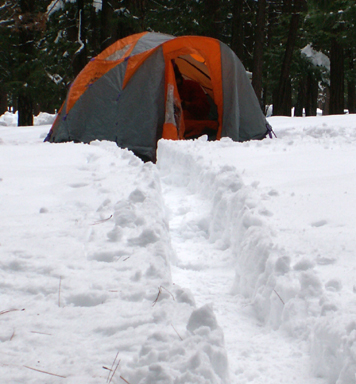
The campers on the 2022 trip had luck because someone who had used one of their campsites after the huge snow storm a few weeks earlier had shoveled a space for tents and paths to and from the picnic table:

This camper made a layer of branches under his tent as he was taught in the Marine Corps. It would be against park rules to cut up tree branches to do this, but on this trip there were a lot of recently downed trees already cut up by park crews. And, yes, he also slept with real insulating sleeping pads.
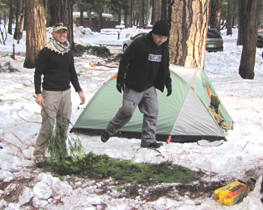
If you brought a pop-up dining canopy on the trip you can use it overnight near your tent, especially if it’s raining instead of snowing. After everyone is done with dinner, move the dining canopy from the picnic table to your tent to turn it into a front porch. Be aware, in high wind you should just take down the canopy. Heavy snow will collapse it. Rain in the evening often turns into snow later overnight when it gets colder.
If it is possible it could snow you should not leave any dining canopy pitched overnight or when you are away from it, as the snow buildup can become too heavy and the canopy can collapse, damaging the canopy, and any tent or person under it.
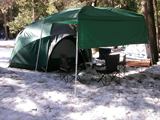
Upon arrival at the campsite snow needed to be cleared from the picnic table and out of the firepit, so it was a smart idea to set up a dining canopy and put a tarp over the firepit when the work was done. But it was not smart to leave the canopy up overnight in the heavy snow as the snow partially collapsed the roof:
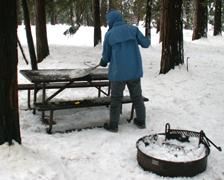
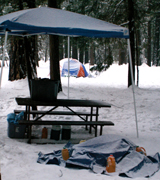

Below, on the left, the correct way to leave a canopy when you are not actually using it, standing under it, and pushing snow off it.
Next to that photo, the result at a neighbor’s campsite who left their canopy up all night, all the canopy poles were bent and mangled:
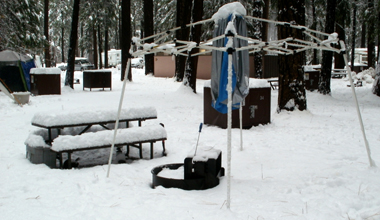
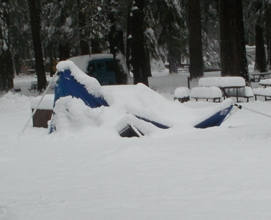
(Yes, the amount of snow you see on the picnic table was one night’s snowfall during this storm. Most snow storms in Yosemite do not dump that much snow in Yosemite valley during one day.)
If you use a tent or dining canopy that needs tent pegs in the ground, please put some pieces of kindling or other small wood pieces in the ground or in the snow sticking up next to the tent/canopy pegs. In low light or no light the pegs and the (usually) white guy lines will be nearly invisible. Help prevent people tripping on your guylines.
You can use bright pink tape to tie on guylines as in this photo:
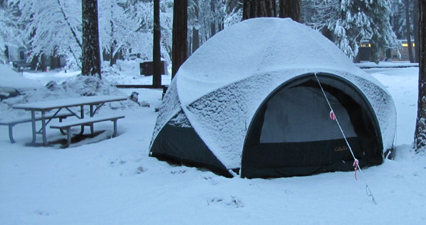
In the picture below of one of our campsites, with a coyote walking through, you can see a piece of pink tape on a guyline, but otherwise you would not be able to spot the line:
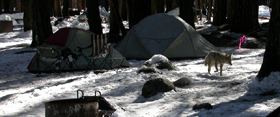
Below: these people made a front porch for their tent from a tarp with poles that needed guylines. They put a piece of kindling where the guyline peg went into the snow (lower left section of the photo). The kinding is quite visible, but the tent guyline isn’t.
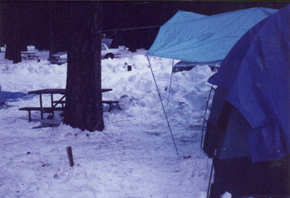
Your lantern mantle may have disintegrated during transport to the park.
(You do bring a spare mantle of the correct size, right?)
It’s easier to put on a lantern mantle in the daylight. At least find your lantern and flashlight (electric torch) before it gets dark.
When you get there, or at least before you go to sleep, stand at the front door of your tent and figure out where the nearest restroom is. In the dark, even with a flashlight or headlamp, finding your way there could leave you lost or at least a bit frustrated.
From your campsite, do you turn right or left on the main campground road?
(Considerate people do not walk right through other people’s campsites, either to get to the restroom or to visit friends in another campsite. And watch out where you shine your flashlight ( right at someone else’s tent could cause consternation.)
The restroom is between which other tents / buildings?
Which end / side is the men’s restroom and which end / side is the women’s?
Which part of the side / end is the entrance?
What route should you take to miss the large puddles that could need wading through if it rains much more?
Before you settle down for an evening’s campfire or a night hike, get dinner cleaned up, trash deposited and your gear in your tent ready. If the weather is lousy you can mop up dirty dishes a little, store them in the bear box and deal with them when you get home. Yosemite rules say to dispose of all trash in the dumpster, not to store it in the bear-proof.
Please recycle propane canisters only in the bins labeled for propane canister recycling rather than throwing them in a trash bin. Likewise, please don’t put trash in the recycling bins.
_____________________________________________________________________
Before you head for bed, put away miscellaneous pieces of equipment even if we don’t expect a fresh snowfall to cover and hide them from us in the morning.
Below: people left gear out on this table overnight. They didn’t expect overnight snowfall because the sky was fairly clear. It would have been a lot easier to pack things up the night before.

This includes things sitting on picnic tables under dining canopies. Heavy snow overnight can make the dining canopy collapse and your potholder, etc. you left out will get soaked and frozen. In the morning you’ll find the lantern frozen to the table top.
The canopy below didn’t collapse from weight of snow, it just wasn’t pitched properly. It had a lantern burning on the table under it when it collapsed and the hot top of the lantern burnt a hole in the canopy.

Before you put away the stove, heat up some water to fill your drinking water bottle (and hot water bottle to keep you warm if you brought one). You could make hot chocolate or soup for a midnight snack, and put it in a thermos, but store it in the bearbox, not in the tent or car. A thermos by itself may not keep things warm, so you might want to plan to bring a spare sock or two to slip it into. Also wrap up propane tanks.
At bedtime, use a flashlight (electric torch) to check under the picnic table for lost potato chips and cooking items you forgot you set down on the ground during cooking.
Below: a cook set down a container of pasta sauce under a picnic table bench and forgot about it. We found it with a quick flashlight sweep.
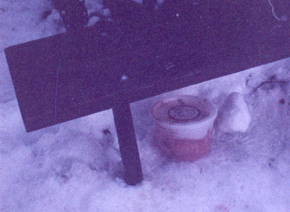
When you take off your gloves/mittens to do work, stuff them inside your jacket to stay warm instead of putting them down in the snow.
Moisture in your car trunk lid and door jams may freeze overnight, and you might not be able to thaw them and open them until it warms up, so store things you might want right away in the morning in your tent. Breakfast equipment and the stove may have some food residue so they should be in the bear box. Store your can of spray de-icer in the bear box instead of the car.
On Friday evening, plan ahead for Saturday morning. Pack your day pack the night before (or a large backpack that will fit everything you’ll need to bring). (Except put the lunch and trail snacks, sunscreen, etc. in the bearbox overnight.) A list of things to bring are at the ‘for a hike’ section of the summer Camping equipment checklist
Leave your shower kit in the bear box, not the tent, tent cabin or the car. The mint toothpaste and Caribbean sunscreen really smell like food to the animals, and there will be coyotes and raccoons (who know how to unzip tent doors)
in the campground, Curry Village (. . . everywhere in Yosemite valley) on and off 24 hours a day, whether people are around or not.
You should have stored your sleeping bag in your car during the day (thefts occur in parks). Take out down bags and fluff them up at least a half hour before bedtime. Be certain down bags, vests, jackets, etc. never get wet –wet down is useless.
It’s going to be cold in the morning and hard to drag yourself out of that warm sleeping bag. But you’ll probably want to get an early start, especially if you want to have time to make and eat a good enough breakfast. Set an alarm. You don’t want to miss the free bus to Badger ski area (snowboarding, cross country and downhill lessons and/or equipment rentals, the ranger snowshoe walk). You’ll want enough time to finish a long hike before dark.
We will have a Saturday morning 7 a.m. (maybe coffee/hot chocolate?) plans-for-the-day-meeting when people can decide which activity they want to participate in, with whom. This early morning meeting is often when many people finally make plans – or change plans. You must bring your flashlight and waterproof rain gear to the meeting and show these to everyone so they can have confidence they want to hang out with you/ hike with you/ ski with you Saturday.
It would have been easier to put the pop-up chair away the evening before it snowed:
Smoking campfires cause a lot of pollution.
How to build a campfire that doesn’t smoke too much is at:
Campfires
There you will find:
The potato chips won a fire starters experiment in competition against dryer lint, dryer lint with candle wax drips (which did quite well), Fritos (which did not do at all well), Cheetos and two flavors of Doritos:

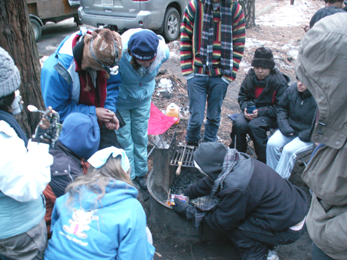
You need good firewood. (FIREWOOD: As long as Sudden Oak Death is still a problem, we must follow quarantines of host material, including local (Santa Clara County and other infected coastal counties) firewood. We can’t even bring cut up scrap lumber or pallets. We need to buy it in the park, or bring Presto type “logs”(compressed sawdust and maybe wax) or “Firewood collection of dead and down wood is permitted within the boundaries of campgrounds in Yosemite Valley, and can otherwise be gathered anywhere in the park that is outside Yosemite Valley, below 9,600 feet, and not in a sequoia grove.”
But the dead and downed wood that is actually burnable available on the ground in campgrounds is rare, so plan ahead to bring presto-type logs or buy bundles / boxes of wood in the park.)
Boxes of firewood you can buy in parks will likely have various sizes of wood pieces. Look for “kindling included” on the box. The branch / log shaped piece in the bottom left corner of this box, not split down the center, should be the last piece you put on, once you have the fire going well enough that it will light.
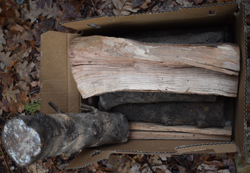
Be sure your kindling (the smallest pieces of firewood) supply stays really dry. Experience shows that you can’t start a fire with damp cardboard, (we have seen people try, because that’s all they had left the last morning).
Most experienced campers build small campfires that can actually keep people warmer than huge blazes you have to stand away from. If your campfire is smoking a lot, get some help.
When it’s time to put out the fire, Yosemite campground regulations say it needs to be put out with water, because a fire that’s just left to burn out or buried in dirt will smolder and pollute the air.
“Fires must be extinguished with water so that coals are cold and no smoke is visible.”
But, if you just pour a bunch of water on a blazing campfire, you’ll create a cloud of steamy smoke with a bunch of ash particles that may bother people two campsites away.
Instead, plan to take the time to put the fire out properly. Don’t put on extra wood really near bedtime. When it’s time to put it out, pull the logs or remaining chunks of glowing charcoal apart, let them die down a little, and then finally sprinkle water on. If it makes huge clouds of steamy smoke, you need to let it die down before you put on more water.
To be sure it’s out completely, move any lanterns away from the area, turn off any flashlights, stir the campfire debris around, then sprinkle more water on any glowing coal bits. Don’t let anybody dissuade you because they say they won’t be able to build a fire the next day (they’re wrong). If you visit Yosemite valley often enough, you will notice the smog and be glad you didn’t contribute to it.
On one trip a girl sat by the campfire on her ice chest, then forgot about it when she went to bed, but not before raccoons tried to get into it (with other people sitting right next to it).
If you’ve been sitting awhile by the fire you’ll want to move around and warm up a little before going to bed.
Check around the campfire area and under the picnic table with a flashlight for stray M&Ms and potato chips. Hike to the trash bin with the last of the trash, or do some sort of exercise to warm up. If you go to bed cold, you’ll stay cold longer because you need to be warm to warm-up your sleeping bag. But, don’t get too sweaty, unless you have a change of inner layer clothes in your bag.
At bedtime double check that your daypack and jacket pockets
are empty of candybars and snacks.
We’ve had people who didn’t and raccoons got into the tents.
Picture crushed Cheetos in or on your sleeping bag.
Picture how happy your tent mates will be with crushed Cheetos on or in their sleeping bags.
Early Saturday morning on the 2013 trip we found a torn open pack sitting just outside the entrance to one of the two-person tents. A raccoon had opened the tent and dragged it out, not even waking the people inside. In the second photo, the camper, not knowing how his pack got there, was concerned that perhaps his camera had been stolen, but that was not what the raccoon wanted. In the foreground of the third picture you can see the yellow chocolate bar wrapper (he and the raccoon share a liking for Toblerone bars). Yes, everyone had been asked to triple check their day packs, pockets, etc., before putting gear in their tents. Yes, he and his tentmate could have been injured if they had woken up when the raccoon was getting the pack out of the tent.
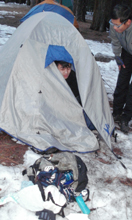
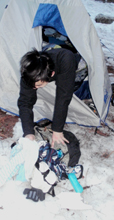

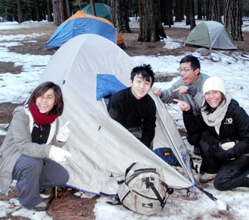
(No, putting a ‘lock’ on the tent zipper will not keep thieves or raccoons out,
they will just tear the tent material to get in.)
Is your inner layer of clothes really sweaty? If so, put a dry set in your sleeping bag to change into, especially socks. Also put two large plastic leaf bags in the tent, a cloth to wipe moisture off rain jackets, a cloth to wipe condensation from the inside of the ceiling and walls mid-night in the morning, and a cloth, a brand new sponge with no scent to it or one of those small super-towels that soak up a lot of water to mop up water (rain… melted snow you tracked in on your boots) from the tent floor.
To get into a small tent, shake the snow off your jacket and sit backwards into the tent rather than walking in. (But don’t sit on your sleeping bag with wet clothes on.) After you sit down, tap your feet together outside of the tent to knock the snow off your boots. Wipe excess moisture off your jacket and put it in a plastic bag, folded so the wet places don’t touch the dry surfaces. Loosen the laces on your boots and put them in another bag.
The bag with your boots should go under the foot end of your sleeping bag or in the foot end if it fits, to keep your boots from freezing. Any removable insoles could go into your sleeping bag.
(Some people decide in advance that no one can walk inside the tent or tent cabin with boots on, to keep snow (and melted snow, dirt) from accumulating inside. In this case you might want booties or slippers of some kind for hanging out in the tent/tent cabin playing cards, etc.)
If your jacket is dry, you can spread it out on top of your sleeping bag, with the inside of the jacket facing down towards the bag, to keep it from getting so cold, but don’t spread wet things over your bag. Why would this work? The thing that makes a sleeping bag warm is you. Your body heat warms the clothes you are wearing, the sleeping bag liner or an inner blanket, the sleeping bag, and a little might go out of the bag into a jacket on top of it. There are limits to how much dispersed warmth can do, though.
Position your sleeping pads and bags so they don’t touch the inside walls of the tent. This means a 6 person tent which really could fit six people (without much gear) in the summer, should only have 3 or 4 people in it on our trip.

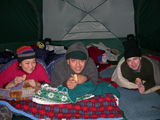
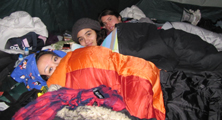
Wrap a knit scarf around your face to pre-warm air by breathing through it. Resist burying your face in your sleeping bag because your moist breath will soak that part of the bag. Leave your knit hat on to make a HUGE difference in how warm you stay. You might also want a bandanna on under the knit hat to be sure your ears stay warm.
If you’re using a sleeping bag without a hood, and with a wide opening at the shoulders, bring an extra blanket to wrap around the opening, so the bag won’t be drafty. Another blanket inside of a wide, non-mummy-shaped bag will also be warmer.
Don’t wear too many clothes to bed. You’ll be warmer if you wear fewer, looser clothes. Tightness around your armpits or the tops of your legs can slow down blood flow. Plus, you’ll sleep better if you can move easily in your sleeping bag. Piling on lots of layers and a jacket and stuffing yourself into your sleeping bag really won’t work.
Leave some tent zippers open part way for ventilation. Yes, even if it’s windy and cold, or else you will have lots of moisture on the interior of your tent caused by your steamy breath condensing — in one night, the average adult exhales a pint of water. If you can, arrange for a low air intake and vent a high outlet.
Store your flashlight and your contact lens kit (in screw top containers instead of pop-open-any-time containers) in the sleeping bag to stay warm. If you will need a mirror to put in the contacts store it in or near the sleeping bag so you don’t have to go hunting for it in the morning.
It’s not good to have your toiletries kit in the tent, the various smells will attract animals, but it’s okay to have a hair brush or comb and mirror.
If you have a thermos that has never had anything but hot water in it (and therefore didn’t pick up any food odors) you could fill it with warm water for overnight drinking. If you don’t have a thermos for your in-the-tent overnight water supply, wrap your water bottle (a water bottle that also never had anything but water in it!) in a sock for extra insulation, and set it on its side or upside down. If you leave it sitting right side up, the thin layer of ice that forms in it on top of the water will keep you from drinking, and expect that the moisture around the cap threads will freeze and you might not be able to open it.
Before getting up in the morning or at night, do some isometric exercises (do crunches, wiggle around and stretch in your sleeping bag) to get blood moving and warm your muscles. Have a clean rag or dishtowel in the tent to wipe moisture off the inside of the tent walls.
This way, you won’t get up and bump the tent and make it drip or ‘rain’ on you (or snow on you, depending on how cold it was). But also have a spare blanket over your bags for the possibility, and leave some tent zippers open part way.
If you’ve been drinking enough water to stay healthy, you will need to get up in the middle of the night. This gives you an opportunity to check the tent for snow accumulation. A little insulation is okay, but knock a bunch off if it’s been snowing heavily. On one club trip a tent collapsed from too much snow (nobody was hurt).
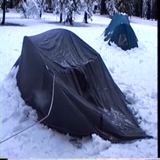
If it isn’t cloudy, take a minute to check out the stars.
The bathrooms are heated, so the first water out of the sink tap might be warmed in the inside pipes and less cold than the flow of water a couple of minutes later; refill your water bottle first.
Hand or toe or foot warmers …small packets of chemicals, which when activated, will produce heat for hours, can be a worthy investment. If you figure out who in your tent will probably get up first in the morning, as soon as you wake up you can put a set of them in the toe end of their boots first to make them more comfortable, then move them to other people’s boots and finally to someone’s jacket pocket for their fingers. If you buy a foot sized pair for boots, be sure they don’t make your boots too tight and cut of circulation to your toes.
(Some kinds can be boiled to be reused. They are more expensive in the short run but can be reused for years and are much more earth-friendly.)
Those for sale in the park have in recent years cost twice as much as those at home.
When it’s time to put in your contact lenses, do it while still in your sleeping bag. Sit up and lean over the top of the bag. Spread the bag material at your lap out smoothly with a depression in the middle. Then if you drop the lens it will fall on the surface of the bag and head towards the center where you will be much more able to find it than on the ground outside or the muddy bathroom floor. Same instructions for putting new batteries in hearing aids.
If your car lock is frozen in the morning, set your car key next to one of those chemical hand warmer packets in your jacket pocket to warm it up, then try it. Gently pushing down on the trunk lid or against a door a few times may break up ice crystals so it will open. Also try de-icer in the locks. Don’t try breathing your hot breath into the lock, the moisture in your breath will just refreeze. Sometimes you just have to wait until it warms up a little, or have everyone climb in the one door that will open.
Invest in enough de-icer. The Centers for Disease Control website warns:
“Never pour water on your windshield to remove ice or snow; shattering may occur.”
You will want deicer for your car windshield, windshield washer nozzles and door locks. A real windshield ice scraper works better than a fabricated one.
On a budget? The Yosemite Daily report said: “Top off your wiper fluid reservoir with freeze-proof fluid, a few tablespoons of rubbing alcohol added to standard fluid works as well.”
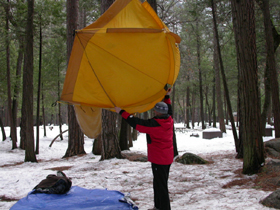
Remember to unpack the tent right away when you get home, wipe it down with a damp sponge as needed and spread it out or, even better, pitch it, so it can dry out. A tent that is even a little damp that is stuffed into a tent bag and forgotten will mildew and smell bad and basically be ruined.
You really need to read Snow camp weather, hike safety and first aid considerations
 Safe driving in rain and fog includes info about driving in fog, on black ice, driving in rain, driving in floods (don’t) and chain requirements, with lots of links to follow.
Safe driving in rain and fog includes info about driving in fog, on black ice, driving in rain, driving in floods (don’t) and chain requirements, with lots of links to follow.
You might also want to read Snow chain rentals, wildlife jams or How to not collide with a deer
Road trip advice and etiquette has links to radio station guides and gasoline prices across the country.
Snow camp carpools and driving directions
There’s easy camping info at: Have more fun camping where you can learn how to build campfires that don’t smoke too much, how to pack an ice chest, do dishes in camp and lots more.
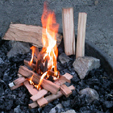
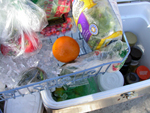
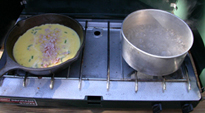
There are crucial things wrong with each of these tents.
If you don’t recognize what is wrong, please read Don’t buy a cheap tent, which has reasons why and more examples of tents to NOT bring.
Camping solutions for women answers typical questions.
Things to do during a Yosemite snow storm besides hiding in your tent
For a laugh and for more pictures of tents to NOT take on our trips scroll down to the bottom of Camping Blunders
For the answer to the question:
How do I convince my parent(s)/guardian that I can go on this trip? or
How do I convince them to pay for some gear for the trip?
Go to: Snow camp FAQs
At bears you will find:
links to general info about bears,
then practicalities of camping and backpacking around bears, (Food Storage , what to do if you see a bear, how bears get into cars, info for backpackers) and lots of stories about bears getting into cars, tents, camps, etc., mostly geared towards De Anza College Outdoor Club trips around bears in California (especially Yosemite National Park) and Grand Teton National Park.
And the answer to the question:
Why don’t the rangers just move the problem bears?
and the question:
How can I keep a bear out of my campsite? (You can’t, but you can almost always keep it out of your food.)
_______________________
You can find basic to extravagant, (a few with a dress code),
casual, fast (grab and go)
or with table-side service,
indoor and outdoor food service
at multiple locations in Yosemite Valley, as well as four grocery stores
but most people try at least one dinner in camp. Snow or rain camp must-haves has menu ideas along with the details about gear and any boots/jacket/sleeping bag rentals we know of.
_______________________
You might want to check out alternate overnight accommodations, in case camping does not quite work out.
You have a number of lodging choices of where to stay overnight in Yosemite Valley in Yosemite National Park, including campsites or
wood-walled cabin without a bath; heated or unheated wood floored, canvas walled and roofed tent cabin; wood walled cabin with a bath
luxury or generic hotel rooms, suites with a bath
_______________________
photos below by Quang-Tuan Luong/terragalleria.com, all rights reserved.
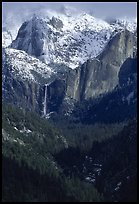
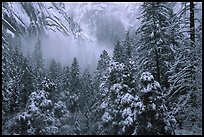


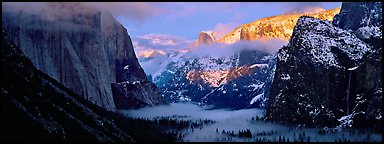
At different times of the day and night on The De Anza Outdoor Club winter Yosemite trip people have seen raccoons, coyotes, deer and ravens in the campsites. We also found tracks in the snow, below raven, raccoon and steel belted radials:
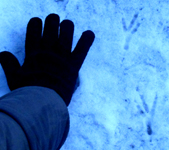
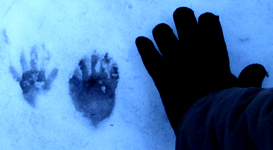
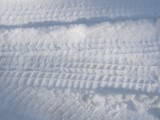
There are many birds in Yosemite all winter.
Some of us refer to the Raven calls near sunrise as the Raven Alarm Clock.
Where were they when they got that great picture in Yosemite?
Where can I take a photo that looks like the one on a Yosemite postcard I just bought?
Places to take photos of Half Dome, Bridalveil Fall, El Capitan, Yosemite Falls and Staircase Falls.

